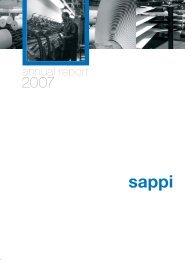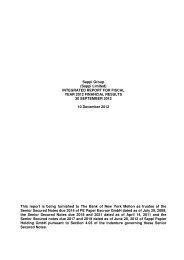SAPPI LTD (SAP) 6-K
SAPPI LTD (SAP) 6-K
SAPPI LTD (SAP) 6-K
You also want an ePaper? Increase the reach of your titles
YUMPU automatically turns print PDFs into web optimized ePapers that Google loves.
Related party financing and hedging arrangements<br />
M-real’s partially owned internal specialised finance company or bank, Metsä Group Financial Services Oy (“Metsä Finance”), has historically been<br />
responsible for managing the Company’s financial position according to the strategy and financial policy of M-real. Metsä Finance’s influence has included<br />
the daily management of cash pooling arrangements, related party contractual financing arrangements and financial and commodity risk hedging. Note 4,<br />
“Related Parties” contains details regarding transactions with the Parent and other related parties to the Company.<br />
Based on long-term capital assessments, Metsä Finance has entered into related party interest bearing loan agreements with certain of the Company<br />
entities. These agreements have contractual maturity dates and interest rates. Interest on these loans is regularly settled through the cash pooling<br />
arrangement. The Company presents loans from the Parent as borrowings in the combined balance sheets. Interest expense on these loans is presented as<br />
other financial expense in the combined income statements.<br />
In the regular course of business, the Company is exposed to certain financial risks which are hedged by either the local business or by Metsä Finance on<br />
positions held by the Company. These risks are typically commodity (energy) prices, foreign currency exposure and translation risk of net investments in<br />
foreign entities. The Company has elected not to allocate hedging positions of the Company specific risk, held by Metsä Finance, to the combined financial<br />
statements.<br />
Standards, amendments and interpretations effective in 2007<br />
IFRS 7, ‘Financial instruments: Disclosures’, and the complementary amendment to IAS 1, ‘Presentation of financial statements – Capital disclosures’. The<br />
standard requires the disclosure of qualitative and quantitative information about exposure to risks arising from financial instruments, including specified<br />
minimum disclosures about credit risk, liquidity risk and market risk, including sensitivity analysis to market risk. The amendment to IAS 1 introduces<br />
disclosures about the level of an entity’s capital and how it manages capital. The standard introduces new disclosures relating to financial instruments, but has<br />
no impact on classification or valuation of the derivatives. The IAS 1 amended Capital disclosures are not relevant to the Company’s combined financial<br />
statements as they are prepared on a “carve-out” basis and normal ways of capital management do not apply to Company’s invested equity.<br />
Standards, amendments and interpretations effective in 2007 but considered not relevant to the Company’s operations<br />
IFRIC 8, ‘Scope of IFRS 2’, requires consideration of transactions involving the issuance of equity instruments, where the identifiable consideration received<br />
is less than the fair value of the equity instruments issued in order to establish whether or not they fall within the scope of IFRS 2. This interpretation does not<br />
have any impact on the Company’s combined financial statements.<br />
IFRIC 9, “Reassessment of Embedded Derivatives”, concludes that an entity should not reassess the conclusion as to whether an embedded derivative needs<br />
to be separated from the hybrid contract after it is initially recognised. This interpretation does not have any impact on the Company’s combined financial<br />
statements.<br />
IFRIC 10, ‘Interim financial reporting and impairment’, prohibits the impairment losses recognised<br />
in an interim period on goodwill and investments in equity instruments and in financial assets carried at cost to be reversed at a subsequent balance sheet date.<br />
This interpretation does not have any impact on the Company’s combined financial statements.<br />
IFRIC 7, ‘Applying the restatement approach under IAS 29, Financial reporting in hyperinflationary economies’.<br />
72
















